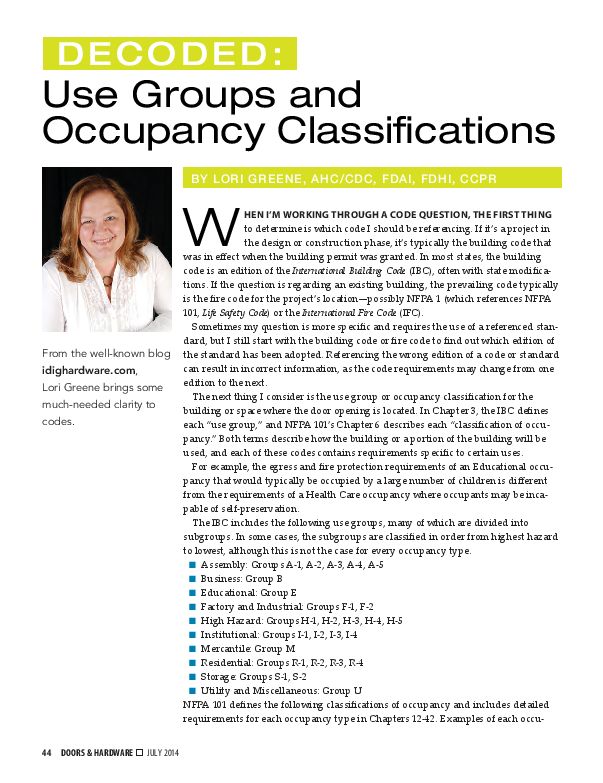After determining which codes and standards (including which editions) apply to a building, the next step is to identify the use group or classification of occupancy, which describes how the building or space will be used. The code requirements sometimes vary, depending on the occupancy type – for example, panic hardware is required for doors serving assembly, educational, and high hazard occupancies of a certain size, so it’s important to know whether the building includes any of those occupancy types.
| The IBC includes the following use groups, many of which are divided into sub-groups. In some cases, the sub-groups are classified in order from highest hazard to lowest, although this is not the case for every occupancy type. | NFPA 101 defines the following classifications of occupancy, and includes detailed requirements for each occupancy type in Chapters 12-42. Examples of each occupancy classification can be found in Annex A of NFPA 101. |
| · Assembly: Groups A-1, A-2, A-3, A-4, A-5 | · Assembly |
| · Business: Group B | · Educational |
| · Educational: Group E | · Day-Care |
| · Factory and Industrial: Groups F-1, F-2 | · Health Care |
| · High Hazard: Groups H-1, H-2, H3, H-4, H-5 | · Ambulatory Health Care |
| . Institutional: Groups I-1, I-2, I-3, I-4 | . Detention and Correctional |
| · Mercantile: Group M | · Residential |
| · Residential: Groups R-1, R-2, R-3, R-4 | · Residential Board and Care |
| · Storage: Groups S-1, S-2 | · Mercantile |
| · Utility and Miscellaneous: Group U | · Business |
| · Industrial | |
| · Storage |
.
 This Decoded article includes more information about occupancy types, and the occupancy classifications from NFPA 101 are defined in the Allegion Code Reference Guide. Some buildings include more than one occupancy type, and small assembly occupancies are commonly found within other occupancy classifications, so there’s an article about small assembly occupancies here.
This Decoded article includes more information about occupancy types, and the occupancy classifications from NFPA 101 are defined in the Allegion Code Reference Guide. Some buildings include more than one occupancy type, and small assembly occupancies are commonly found within other occupancy classifications, so there’s an article about small assembly occupancies here.
For more information about specific use groups and occupancy classifications, refer to the study materials for NFPA 101 – The Life Safety Code and the International Building Code (IBC).
If you REALLY want to test your understanding of occupancy types, you can click here to download an optional practice exercise and use your copy of the IBC to identify each use group and subgroup.
Once you have reviewed these articles and study materials, proceed to the review questions below.
~~~
Review Questions
1. It’s important to identify the IBC Use Group or NFPA 101 Occupancy Classification because:
- The occupancy type must be posted near the building entrance.
- The code requirements may vary depending on the occupancy type.
- Law enforcement will need to know whether the building is being used for the approved purpose.
- All of the above
2. According to the IBC, a large restaurant would be considered which use group?
- Group A – Assembly
- Group B – Business
- Group M – Mercantile
- Group R – Restaurant
3. According to NFPA 101, a clothing store would be considered which occupancy classification?
- Assembly Occupancy
- Business Occupancy
- Mercantile Occupancy
- Retail Occupancy
Answers: 1 – B, 2 – A, 3 – C
